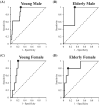Phase angle from bioelectrical impedance analysis is a useful indicator of muscle quality
- PMID: 34845859
- PMCID: PMC8818694
- DOI: 10.1002/jcsm.12860
Phase angle from bioelectrical impedance analysis is a useful indicator of muscle quality
Abstract
Background: Methods that facilitate muscle quality measurement may improve the diagnosis of sarcopenia. Current research has focused on the phase angle (PhA) obtained through bioelectrical impedance analysis (BIA) as an indicator of cellular health, particularly cell membrane integrity and cell function. The current study therefore aimed to evaluate the relationship between the PhA and muscle quality and muscle-related parameters and to determine factors associated with the PhA. Moreover, we attempted to determine the cut-off value of PhA for predicting sarcopenia.
Methods: First-year university students (830 male students, 18.5 ± 0.6 years old; 422 female students, 18.3 ± 0.5 years old) and community-dwelling elderly individuals (70 male individuals, 74.4 ± 5.5 years old; 97 female individuals, 73.1 ± 6.4 years old) were included. PhA and other body composition data were measured using BIA, while muscle quality was calculated by dividing handgrip strength by upper limbs muscle mass. The relationship between PhA and the aforementioned parameters were then analysed, after which the cut-off value of PhA for predicting sarcopenia was examined.
Results: Multiple linear regression analysis revealed that age, skeletal muscle mass index (SMI), and muscle quality were independently associated with PhA in both sexes [male (age: standardized regression coefficient (β) = -0.43, P < 0.001, SMI: β = 0.61, P < 0.001, muscle quality: β = 0.13, P < 0.001) and female (age: β = -0.56, P < 0.001, SMI: β = 0.52, P < 0.001, muscle quality: β = 0.09, P = 0.007)]. Participants with sarcopenia had a significantly lower PhA compared with those without it (sarcopenia vs. non-sarcopenia: young male participants, 5.51 ± 0.41° vs. 6.25 ± 0.50°, P < 0.001; young female participants, 4.88 ± 0.16° vs. 5.37 ± 0.44°, P = 0.005; elderly female participants: 4.14 ± 0.29° vs. 4.63 ± 0.42°, P = 0.009). Although no significant findings were observed in elderly male participants, the same tendency was noted. Receiver operating characteristic (ROC) curve analysis indicated that PhA had good predictive ability for sarcopenia in young male, elderly male, young female, and elderly female participants (area under the ROC curve of 0.882, 0.838, 0.865, and 0.850, with cut-off PhA values of 5.95°, 5.04°, 5.02°, and 4.20° for predicting sarcopenia, respectively).
Conclusions: The PhA reflected muscle quality and exhibited good accuracy in detecting sarcopenia, suggesting its utility as an index for easily measuring muscle quality, which could improve the diagnosis of sarcopenia.
Keywords: Bioelectrical impedance; Body composition; Muscle quality; Phase angle; Sarcopenia.
© 2021 The Authors. Journal of Cachexia, Sarcopenia and Muscle published by John Wiley & Sons Ltd on behalf of Society on Sarcopenia, Cachexia and Wasting Disorders.
Conflict of interest statement
All authors of this manuscript declare no conflicts of interest.
Figures
References
-
- Freilich RJ, Kirsner RL, Byrne E. Isometric strength and thickness relationships in human quadriceps muscle. Neuromuscul Disord 1995;5:415–422. - PubMed
Publication types
MeSH terms
LinkOut - more resources
Full Text Sources
Other Literature Sources



